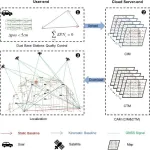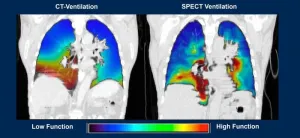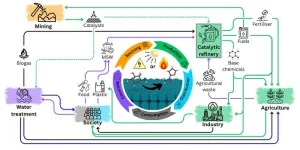(Press-News.org) Two-dimensional materials such as graphene promise to form the basis of incredibly small and fast technologies, but this requires a detailed understanding of their electronic properties. New research demonstrates that fast electronic processes can be probed by irradiating the materials with ions first.
A collaboration involving researchers at the University of Illinois Urbana-Champaign and the University of Duisburg-Essen has shown that when graphene is irradiated with ions, or electrically charged atoms, the electrons that are ejected give information about the graphene’s electronic behavior. Moreover, the Illinois group performed the first calculations involving high-temperature graphene, and the Duisburg-Essen group experimentally verified the predictions by irradiation. This research was reported in the journal Nano Letters.
“Irradiating materials and observing the change in properties to deduce what’s going on inside the material is a well-established technique, but now we are taking first steps towards using ions instead of laser light for that purpose,” said André Schleife, the Illinois group lead and a professor of materials science & engineering. “The advantage is that ions allow highly localized, short-time excitations in the material compared to what laser light can do. This enables high-precision studies of how graphene and other 2D materials evolve over time.”
When an ion collides with a 2D material, energy is transferred to both the atomic nuclei and electrons. Some of the electrons are given enough energy to be ejected from the material. The features of these so-called “secondary electrons” are determined by the characteristics of the electrons in the material such as their temperature and distribution of energies.
“There’s a delay between the ion’s ‘impact’ and secondary electron emission, and that’s the key piece of information that we were after in our simulations,” said Yifan Yao, the study’s lead author and a graduate student in Schleife’s research group. “We did this for graphene at absolute zero with no thermal energy present as well as graphene that has thermal energy and a higher temperature. We’re actually the first to be simulating ‘hot’ graphene like this.”
The Illinois group performed calculations based on graphene irradiated with hydrogen ions – bare protons – and computed how secondary electrons were released over time and their resulting energy spectrum. These results agreed well with the Duisburg-Essen group’s results that used argon and xenon ions.
In addition, the computational study provides insight into the underlying mechanisms of secondary electron emission. High-temperature graphene released more secondary electrons, and a careful examination of the charge distributions indicated that the atomic nuclei in the material’s lattice rather than the material’s electrons are responsible.
According to Schleife, the promise of this technique goes beyond precision 2D material measurements. “Looking years into the future, there’s a possibility that ion irradiation can be used to deliberately introduce defects into materials and manipulate them,” he said. “But, in the near term, we have shown that irradiation can be used as a high-precision measurement technique.”
The article, “Nonequilibrium Dynamics of Electron Emission from Cold and Hot Graphene under Proton Irradiation,” is available online. DOI: 10.1021/acs.nanolett.4c00356
Alina Kononov of Sandia National Laboratories and Arne Metzlaff, Andreas Wucher, Lukas Kalkhoff, Lars Breuer and Marika Schleberger of the University of Duisburg-Essen also contributed to this work.
This work made use of the Argonne Leadership Computing Facility, a U.S. Department of Energy Office of Science User Facility, and the Illinois Campus Cluster Program in conjunction with the National Center for Supercomputing Applications at Illinois.
Support was provided by the National Science Foundation and the German Research Foundation.
END
Ion irradiation offers promise for 2D material probing
2024-05-17
ELSE PRESS RELEASES FROM THIS DATE:
Scientists develop new geochemical ‘fingerprint’ to trace contaminants in fertilizer
2024-05-17
DURHAM N.C. – An international team of scientists has uncovered toxic metals in mineral phosphate fertilizers worldwide by using a new tool to identify the spread and impact of such contaminants on soil, water resources, and food supply.
“While mineral phosphate fertilizers are critical to boost global sustainable agriculture and food security, we found high levels of toxic metals in many fertilizers worldwide,” said Avner Vengosh, chair of the Earth and Climate Sciences division at Duke University’s Nicholas School of the Environment. “Our study developed a new method to identify sources and impacts of these metals on the environment.” Those ...
From the road to the cloud: leveraging vehicle GNSS raw data for spatial high-resolution atmospheric mapping and user positioning
2024-05-17
Innovative Global Navigation Satellite System (GNSS) positioning technologies harness massive vehicle-generated data to create high-resolution atmospheric delay correction maps, significantly enhancing Global Positioning System (GPS) accuracy across varied spatial scales. This new method exploits real-time, crowd-sourced vehicle GNSS raw data, refining traditional GPS applications and presenting a cost-effective solution for precise positioning.
The quest for enhanced Global Navigation Satellite System (GNSS) accuracy has been hindered ...
Study suggests that air pollution promotes inflammation in the brain, accelerating cognitive decline and increasing risk of dementia
2024-05-17
Results from new study suggests that long-term exposure to air pollution leads to increased risk in dementia in Denmark.
"We also find association with noise, but this seems to be explained by air pollution primarily. Our study is in line with growing international knowledge on this topic." says Professor at Section of Environmental Health Zorana Jovanovic Andersen.
This is an important finding which adds that air pollution, beyond well-known effects on respiratory and cardiovascular system, also has major impacts on our brain, promoting inflammation in the brain, accelerating cognitive decline, and increasing ...
New imaging software improves lung diagnosis for 30% of patients who can't tolerate contrast dye; has added diagnostic benefits for all patients
2024-05-17
Southfield, Mich., May 17, 2024 – For up to 30% of patients who are allergic to medical contrast dye or have a dye restriction because of other health conditions, they might find that it takes longer to get a diagnosis when it comes to life-threatening lung issues such as pulmonary embolism. That's because imaging methods that detect lung problems but don't use contrast dye aren't as accurate and can be more time-consuming to administer.
Now, new imaging software, developed by pulmonologist Girish Nair, M.D., with Corewell Health William Beaumont University Hospital in Royal Oak, Michigan, and biomedical ...
A trial HIV vaccine triggered elusive and essential antibodies in humans
2024-05-17
DURHAM, N.C. – An HIV vaccine candidate developed at the Duke Human Vaccine Institute triggered low levels of an elusive type of broadly neutralizing HIV antibodies among a small group of people enrolled in a 2019 clinical trial.
The finding, reported May 17 in the journal Cell, not only provides proof that a vaccine can elicit these antibodies to fight diverse strains of HIV, but that it can also initiate the process within weeks, setting in motion an essential immune response.
The vaccine candidate targets an area on the HIV-1 outer envelope called the membrane proximal external region (MPER), which ...
Can we revolutionise the chemical industry and create a circular economy? Yes, with the help of catalysts
2024-05-17
The chemical industry is a cornerstone of global development, driving innovation, and providing essential products that support our modern way of life.
However, its reliance on unsustainable fossil resources has posed significant threats to global ecosystems through climate change and chemical pollution.
A new commentary published in Cell Press’ OneEarth co-authored by Griffith University researchers puts forth a transformative solution: catalysis to leverage sustainable waste resources, ushering the industry from a linear to a circular economy.
“If ...
Rutgers researchers identify impacts of Russia-Ukraine war on hospitals
2024-05-17
Rutgers researchers, aided by international collaborators, have tracked the devastation war has made on Ukraine’s hospital system.
Hundreds of hospitals in Ukraine have been forced to close or operate at a reduced capacity since Russia’s invasion of the Eastern European country in February 2022. Damage, destruction and supply shortages caused by the war have impaired the nation’s hospital system and taken a serious toll on human health.
In a study published in JAMA, Rutgers researchers and collaborators from the United States, Pakistan and Ukraine collected and compared data on hospital services provided both during ...
Differing values of nature can still lead to joined up goals for sustainability
2024-05-17
Recognising and respecting the different ways nature is valued can enable better environmental decision-making, according to new research led by the University of East Anglia (UEA).
International agreements such as the Sustainable Development Goals represent wide support for a sustainable future, living within planetary boundaries and ensuring a safer future for current and next generations.
However, there remain huge disagreements about how to advance such goals, often resulting in marginalisation, conflict and inaction.
The paper, published in the journal One Earth, ...
Ultraprocessed food consumption and cardiometabolic risk factors in children
2024-05-17
About The Study: The findings of this study suggest that high ultraprocessed food (UPF) consumption in young children is associated with adiposity and other cardiometabolic risk factors, highlighting the need for public health initiatives to promote the replacement of UPFs with unprocessed or minimally processed foods.
Corresponding Author: To contact the corresponding author, Nancy Babio, Ph.D., email nancy.babio@urv.cat.
To access the embargoed study: Visit our For The Media website at this link https://media.jamanetwork.com/
(doi:10.1001/jamanetworkopen.2024.11852)
Editor’s ...
Link between e-cigarette use and early age of asthma onset in US adults found through UTHealth Houston research
2024-05-17
A significant link between the use of electronic cigarettes and earlier age of asthma onset in U.S. adults was reported by UTHealth Houston researchers May 17, 2024 in the Journal of the American Medical Association (JAMA) Network Open.
Led by first author Adriana Pérez, PhD, MS, professor of biostatistics and data science at UTHealth Houston School of Public Health, the research found that adults who were asthma-free at the beginning of the study and reported e-cigarette use in the past 30 days increased their risk of developing earlier age of asthma onset by 252%.
“While previous studies have reported that e-cigarette use increases ...





